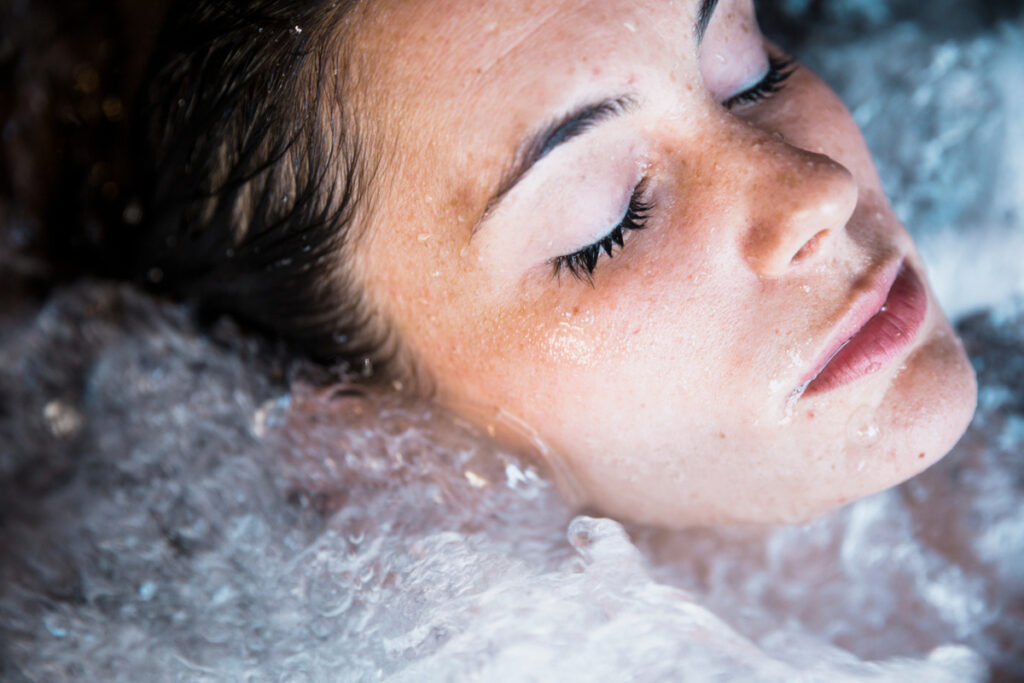Do ice baths burn fat?
This is a question that has sparked considerable interest, particularly among athletes and fitness enthusiasts who are always looking for new ways to enhance their performance and lose weight.
Ice baths, or cold water immersion, have long been used to promote muscle recovery after intense physical activity, but can they also contribute to fat loss?
In this article, we will explore the science behind ice baths, how they may impact fat metabolism, and whether this technique is effective for weight loss.
Do Ice Baths Burn Fat?
Ice baths involve sitting or immersing the body in ice-cold water for a period of time, usually between 10 to 20 minutes.
The key idea behind using cold water therapy for weight loss is the potential impact on the body’s metabolism and fat-burning processes.
When exposed to cold temperatures, the body works hard to maintain its core temperature, activating thermogenesis.
Thermogenesis is the process where the body burns calories to generate heat in response to cold exposure.
The primary mechanism by which ice baths are thought to burn fat is through the activation of brown adipose tissue (BAT), also known as brown fat.
Brown fat is a type of fat that is metabolically active and burns energy to generate heat, as opposed to white fat, which stores energy.
Some studies suggest that cold exposure can stimulate the activity of brown fat, leading to an increase in calorie burn and, potentially, fat loss.
The Physiology Behind Cold Exposure and Fat Loss
To understand how ice baths may promote fat loss, it’s important to first look at how the body responds to cold exposure.
When the body is exposed to cold, it activates several physiological responses to preserve heat.
One of these responses is the stimulation of brown adipose tissue, which burns calories to create heat and keep the body warm.
In fact, research has shown that cold exposure can increase the amount of brown fat in the body, particularly in areas like the neck and upper chest.
As brown fat burns calories, it contributes to overall energy expenditure, which could support fat loss over time.
Additionally, cold exposure has been shown to increase metabolic rate, further contributing to the body’s ability to burn fat.
This metabolic boost may be short-term, but repeated cold exposure could have cumulative effects on fat burning over time.
Can Ice Baths Help with Weight Loss or Just Recovery?
While ice baths may help stimulate fat-burning mechanisms, they are primarily used for muscle recovery rather than weight loss.
After intense exercise, muscle fibers undergo microscopic damage, and ice baths can help reduce inflammation, minimize soreness, and speed up recovery.
Cold exposure constricts blood vessels, which reduces swelling and helps flush out metabolic waste products from the muscles.
In terms of weight loss, the fat-burning effects of ice baths are likely minimal compared to traditional methods like exercise and diet.
However, if used consistently as part of a broader fitness routine, ice baths could potentially contribute to overall fat loss by increasing the body’s ability to burn calories.
It is important to remember that cold therapy should not be considered a primary tool for weight loss, but rather a supplementary technique.
The Benefits and Risks of Cold Therapy for Fat Loss
Ice baths can provide several benefits beyond potential fat loss, including improved recovery and reduced inflammation.
For athletes, this can lead to better performance and less downtime between workouts, helping them stay on track with their fitness goals.
However, cold exposure is not without risks.
Prolonged exposure to ice-cold water can lead to hypothermia, frostbite, and other cold-related injuries if not done correctly.
It is essential to practice safety by limiting the duration of the ice bath and ensuring that the water temperature is not too low.
Additionally, ice baths may not be suitable for individuals with certain medical conditions, such as heart disease or poor circulation, as they can strain the cardiovascular system.
Consulting with a healthcare provider before incorporating ice baths into your routine is always a good idea, especially if you have any preexisting conditions.
Complementing Ice Baths with Other Weight Loss Strategies
While ice baths may offer some benefits for fat burning, they should not replace other proven weight loss strategies like diet and exercise.
To achieve sustainable weight loss, it’s important to combine cold therapy with a balanced diet and regular physical activity.
Exercise, particularly strength training and high-intensity interval training (HIIT), is one of the most effective ways to increase calorie burn and promote fat loss.
A healthy, nutrient-dense diet rich in whole foods like vegetables, lean proteins, and healthy fats supports fat loss by helping regulate hormones, reduce inflammation, and maintain a healthy metabolism.
By combining ice baths with these foundational strategies, you can optimize your fat-burning potential and achieve your weight loss goals more effectively.
Are Ice Baths Effective for Everyone?
The effectiveness of ice baths for fat loss may vary from person to person.
Some individuals may respond better to cold exposure than others, depending on factors like body composition, fitness level, and genetic predisposition to brown fat activation.
For people with higher amounts of brown fat, cold exposure may have a more significant effect on calorie burning and fat loss.
However, for others, the impact of ice baths on fat loss may be minimal.
That said, ice baths can still be beneficial for improving recovery, reducing soreness, and enhancing overall performance, even if they don’t lead to significant fat loss.
Tips for Safely Using Ice Baths for Weight Loss
If you decide to incorporate ice baths into your weight loss or fitness routine, it’s important to do so safely.
Start with shorter sessions and gradually increase the duration as your body becomes accustomed to the cold.
The water temperature should be between 50-59°F (10-15°C), and sessions should be limited to 10-15 minutes to prevent hypothermia.
Always listen to your body and avoid staying in the ice bath if you feel faint, numb, or uncomfortable.
It’s also important to warm up gradually after the bath, either by taking a warm shower or allowing your body to naturally return to normal temperature.
Natural Supplements to Support Weight Loss
In addition to using ice baths, there are natural supplements that can help accelerate fat loss and support your metabolism.
One such supplement is OrexiBurn, a natural weight loss formula designed to boost metabolism, regulate appetite, and promote fat burning.
OrexiBurn contains ingredients like L-arginine, bioflavonoids, and Ecklonia cava, which work together to enhance circulation, support healthy metabolism, and reduce inflammation.
By incorporating OrexiBurn into your daily routine, you can further optimize your fat-burning efforts and support your overall weight loss journey.
While ice baths can help stimulate fat-burning processes and improve recovery, they should be viewed as part of a holistic approach to weight loss.
By combining cold therapy with exercise, a balanced diet, and supplements like OrexiBurn, you can maximize your results and achieve your weight loss goals more effectively.
Learn more about how OrexiBurn can support your weight loss journey by visiting the official website.









